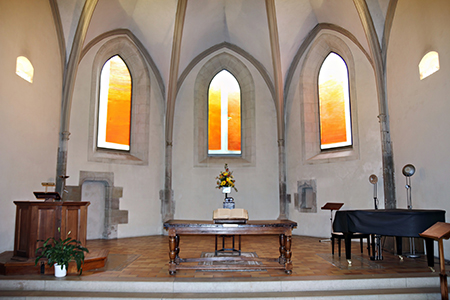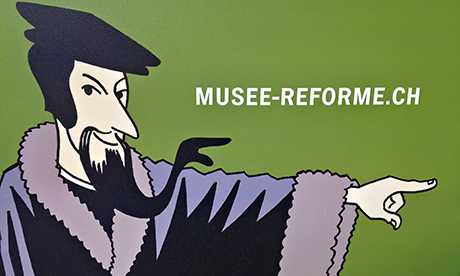October 31 was Reformation Day.
On that day in 1517 Martin Luther may or may not have nailed his 95 Theses on indulgences to the door of the Wittenberg church.
He certainly did send them to the Archbishop of Mainz, thus initiating a movement that became the Protestant Reformation.
When I was a schoolboy, I was sure the Reformation was a disaster.
Without it, England would have remained Catholic, the Church would have been undivided, wars would have been avoided, Europe would have been Catholic, and everyone would have been happier. I grew up in a Catholic world then.
Now, after having taught theology for many years with friends and colleagues from Protestant churches, I wonder what the world would really have been like today if the Reformation had not happened?
Would it really have been a better Church and a better world?
And how, indeed, can we evaluate these enormous historical events?
Violent events such as wars of religion, burnings at stakes, the sacking of churches and the dissolution of monasteries all speak of loss and destruction.
Some of these events would certainly not have happened had the Church remained undivided.
But others may have persisted.
The images of destroyed and alienated monasteries, for example, suggest a violent break with the past.
But the alienation of monasteries began well before the Reformation – even in England Henry VIII embarked on it while he still opposed the Reformers.
It was a pragmatic decision.
Suppressing the monasteries provided finance needed for his wars and strengthened the loyalty of Nobles who were given title to monastic properties.
The closing of monasteries in Protestant territories in Europe was supported by Reformed doctrine and popular zeal, but there, too, it provided rulers with revenue.
The growing power and independence of rulers in their relationship to the Catholic Church at the time suggest that raiding church wealth would at some time proved irresistible to rulers of any stripe.
When the pope suppressed the Jesuits two centuries later it was under pressure from the Catholic kingdoms of Spain, France and Portugal, which took over their schools, churches and other property.
The Religious Wars that followed the Reformation caused terrible suffering in Europe and alienated people from churches.
Religion was certainly the flag under which armies marched.
But the continuing wars between Catholic Spain and France and their incursions into other Catholic regions and into the New World suggest that Rulers would have waged war with equal ferocity in a Catholic world and in their new colonies.
All this suggests that a world without the Reformation might not have been much more peaceful or united.
The deeper question, however, is whether and how the Reformation has shaped our imagination for the better or for the worse.
This is a subjective question, begging to be answered through personal experience.
Regret at the divisions and separation
For many young Catholics of my generation, the legacy of the Reformation certainly contributed to our suspicion of Anglicans, whom we lumped together with Protestants, whose Churches were not real Churches, and whose faith was equally erroneous.
This religious prejudice added spice to sporting competitions with other schools and fed a tribal sense of identity.
It may well have existed anyway, however, between children whose parents were of the English establishment and those born to poor Irish immigrants.
The stories of the wrongs of Ireland and the heroism of Australia’s Archbishop Mannix in defending the Catholic Community received attention equal to that given to the Elizabethan martyrs and contributed to the ways many young Catholics saw the world.

Once a Catholic church in Geneva.
Reformation positives
It was only later that the Reformation touched my imagination in positive ways.
A Methodist lady encountered on a parish census impressed me with a rare quality I could only describe as holiness.
Reading Luther’s writings, I was moved initially by their fire and by his emphasis on faith and salvation as God’s wholly undeserved gift.
On returning to them at a time of self-doubt and discouragement associated with a rules-bound faith, I responded to the depth out of which they were written. His account of the relationship between grace and works may have been wrong, I thought, but he understood the question.
At the same time, I came to appreciate the richness of J S Bach’s cantatas and the power of hymns in Protestant worship.
A Methodist colleague compared the depth of the presence of Christ in the Methodist Hymn Book to that of Christ in the Eucharist for Catholics.
In the hymns of the Wesley brothers, I found a richness of Biblical theology, a care for language and a wealth of imagery largely lacking in the popular Catholic repertoire.
Teaching theology in an ecumenical college, too, revealed to me the strength and seriousness of theology that came out of the Reformed tradition.
In my forays into Karl Barth’s monumental multi-volume Church Dogmatics, I did not warm to his theological starting point but was deeply impressed by his massive reading, exploration of Scripture and care and passion in argument.
He set a standard of seriousness in reflection on faith, as well as a surprising lightness in the use of daring imagery.
In order to describe the depth at which God shared our human misery in Jesus, for example, he divided his treatment of Jesus into two sections: The Journey of the Son of God into a Far Country, and The Homecoming of the Son of Man. To use the career of the Prodigal Son as the matrix for the Incarnation was breathtaking.
Reinhold Niebuhr and his brother H Richard Niebuhr, too, stimulated my interest in the connections between faith, culture and public life, especially as they affected people who were oppressed and disadvantaged.
My appreciation of the richness of the Reformed tradition was not simply aesthetic or intellectual.
It was mediated by people who took Christian faith seriously and lived it, especially by my fellow teachers and students.
In them, the doctrine, Church organisation, and liturgy that were initially seen from the outside took flesh in persons and communities wrestling with the same challenges that we faced.
The smallness of congregations, once seen as a sign of weakness, for example, was experienced as a strength in reaching out promptly to people in need
The Reformation now stirs in me the mixed response that a bitter divorce within a family might evoke.
Within it is the pity and shame that we should have allowed a relationship to come to this, and regret at the divisions and separation that followed the divorce.
Within the response, too, is admiration and gratitude for the richness and generosity found in families on both sides of the initial divide and the desire for a full reconciliation.
Reformation by its nature is never completed.
- Andrew Hamilton SJ is a writer at Jesuit Social Services (Australia). He taught theology at the United Faculty of Theology for many years, and has contributed widely to theological and religious journals. He has had a long-standing engagement with refugee communities and issues and is consulting editor of Eureka Street where this article originally appeared.
- Republished with permission of the author.
News category: Analysis and Comment, Great reads.




